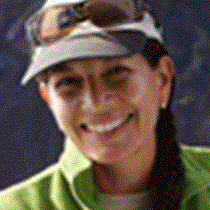Genovesa Island
The spectacular island of Genovesa, also known by the English name of Tower (after a British admiral), is one of the highlights of the week. Early in the morning we arrived at the huge submerged caldera of this dormant volcano, surrounded by frigatebirds, red-footed boobies, swallow-tailed gulls, storm petrels and tropicbirds – an overwhelming seabird experience.
As an early riser, I enjoyed coffee and snacks on the pool deck with some guests, admiring the beautiful scenery of Darwin Bay, with young boobies and frigatebirds flying nearby.
Genovesa has two visitor sites, but because of the capacity limitations for each site determined by the Galápagos National Park, half of us visited one site while the other half visited the other; in the afternoon we switched sites to keep everyone happy.
The group I was leading visited Prince Philip's Steps first, a narrow fissure in the cliff that we hiked up to follow the trail through a Palo Santo forest to a storm petrel colony, passing boobies and frigates along the way. Our main attractions were not only the red-footed boobies and frigatebirds, but also the huge colony of over 200,000 storm petrels nesting on the lava fields, favorite prey for the short-eared owls, which hunt during the day. We were lucky enough to find two owls, one of them feeding on a recently killed storm petrel!
After our morning hike, we all came back on board to change quickly for our last and exciting snorkel outing, in the search of the magnificent hammerhead sharks! Some of our guess did see few of them, but all of us were delighted to see large schools of mobulas and golden rays, swimming gracefully below us.
Lunch was ready when we came back and immediately after we were ready again – this time out on deck with our cameras – to enjoy a kayak regatta where guests and crew performed their best kayaking abilities.
At 3:00 p.m. it was time to go ashore at Darwin’s Bay beach, a beautiful site with white coral sand and hundreds of boobies and frigates. The trail goes by a mangrove area, favorite nesting site for the red-footed boobies and then by a salt bush area, favorite nesting site for the frigatebirds. Beyond the beach area we walked over sharp and irregular lava terrain among the brushy vegetation, ending up at a slight cliff with an incredible view over the bay. On the way back, the light was perfect for taking pictures, and our young guests enjoyed the wonderful crystalline waters of the tide pools.
With a beautiful sunset, and the National Geographic Endeavour leaving Genovesa, we end this expedition with new friends and a better understanding of how important it is for us to keep the islands protected for future generations.




